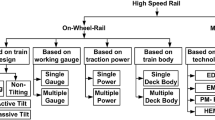Abstract
Communication-based train control (CBTC) uses wireless networks, such as wireless local area networks (WLANs), to transmit trains status and control commands. CBTC systems have stringent requirements for train-ground communications, as the train control system depends on the accurate, timely and reliable data over the communication links. However, since WLANs are not originally designed for high mobility environment, random packet delay and losses are inevitable in WLAN-based CBTC systems, which could result in unnecessary traction, brake or even emergency brake of trains, losses of line capacity and passenger satisfaction. In this paper, we study the impacts of random packet delay on the performance of CBTC systems, and propose a novel scheme to improve the CBTC performance by mitigating the impacts of random packet delay. Unlike the existing works that only consider a single train, we consider a group of trains in CBTC systems to improve the CBTC performance. Extensive field test and simulation results are presented. We show that the current adopted control scheme in CBTC systems needs to keep stability and performance under transmission delays through increasing the distance between trains in steady state which means cost of line capacity. By contrast, our proposed scheme can significantly improve the CBTC performance.

















Similar content being viewed by others
References
Pascoe, R., & Eichorn, T. (2009). What is communication-based train control? IEEE Vehicular Technology Magazine, 4(4), 16–21.
IEEE standard for communications-based train control (CBTC) performance and functional requirements. IEEE 1474.1-2004 Std.
Aguado, M., Jacob, E., Saiz, P., Unzilla, J., Higuero, M., & Matias, J. (2005). Railway signaling systems and new trends in wireless data communication. In Proceedings of IEEE VTC2005-FALL, Sep. 2005, pp. 1333–1336.
Lardennois, R. (2003). Wireless communication for signaling in mass transit. Siemens Transportation Systems, Sep. 2003.
Kuun, E., & Richard, W. (2004). Open standards for CBTC and CCTV radio-based communication. Alcatel Telecommunications Review, 2, 243–252.
Howlett, P. (1990). An optimal strategy for the control of a train. Journal of the Australian Mathematical Society, Series B, 31(Part 4), 454–471.
Jiaxin, C., & Howlett, P. (1993). A note on the calculation of optimal strategies for the minimization of fuel consumption in the control of trains. IEEE Transactions on Automatic Control, 38(11), 1730–1734.
Howlett, P. (2000). The optimal control of a train. Annals of Operations Research, 98, 65–87.
Howlett, P. (1996). Optimal strategies for the control of a train. Automatica, 32(4), 519–532.
Howlett, P., & Cheng, J. (1997). Optimal driving strategies for a train on a track with continuously varying gradient. Journal of the Australian Mathematical Society, Series B, 38(Part 3), 388–410.
Howlett, P. G., Pudney, P. J., & Vu, X. (2009). Local energy minimization in optimal train control. Automatica, 45(11), 2692–2698.
Zhu, L., Yu, F., & Ning, B. (2010). A seamless handoff scheme for train-ground communication systems in CBTC. In Proceedings of IEEE VTC’10-Fall, Ottawa, ON, Canada, pp. 1–5.
Toledo, A., & Wang, X. (2006). TCP performance over wireless MIMO channels with ARQ and packet combining. IEEE Transactions on Mobile Computing, 5(3), 208–223.
Zhu, L., Yu, F. R., Ning, B., & Tang, T. (2011). Cross-layer design for video transmissions in metro passenger information systems. IEEE Transactions on Vehicular Technology, 60(3), 1171–1181.
Middleton, R., & Braslavsky, J. (2010). String instability in classes of linear time invariant formation control with limited communication range. IEEE Transactions on Automatic Control, 55(7), 1519–1530.
Hedrick, J., Tomizuka, M., & Varaiya, P. (1994). Control issues in automated highway systems. IEEE Control Systems Magazine, 14(6), 21–32.
Levine, W., & Athans, M. (1966). On the optimal error regulation of a string of moving vehicles. IEEE Transactions on Automatic Control, 11(3), 355–361.
Hespanha, J., Naghshtabrizi, P., & Xu, Y. (2007). A survey of recent results in networked control systems. Proceedings of the IEEE, 95(1), 138–162.
Baillieul, J., & Antsaklis, P. (2007). Control and communication challenges in networked real-time systems. Proceedings of the IEEE, 95(1), 9–28.
Zampieri, S. (2008). Trends in networked control systems. In 17th IFAC World Congress, pp. 2886–2894.
IEEE standard for information technology-telecommunications and information exchange between systems-local and metropolitan area networks-specific requirements Part11 Wireless LAN medium acess control (MAC) and physical layer (PHY) specifications, IEEE 802.11-2007 Std.
Zhang, W., Branicky, M., & Phillips, S. (2001). Stability of networked control systems. IEEE Control Systems Magazine, 21(1), 84–99
Garcia-Rivera, M., & Barreiro, A. (2007). Analysis of networked control systems with drops and variable delays. Automatica, 43(12), 2054–2059.
Leung, K., Clark, M., McNair, B., Kostic, Z., Cimini, L., & Winters, J. (2007). Outdoor IEEE 802.11 cellular networks: Radio and MAC design and their performance. IEEE Transactions on Vehicular Technology, 56(5), 2673–2684.
Zhu, L., Zhang, Y., Ning, B., & Jiang, H. (2009). Train-ground communication in CBTC based on 802.11b: Design and performance research. In Proceedings of CMC’09, vol. 2, pp. 368–372.
Ogata, K. (1967). State space analysis of control systems. Englewood Cliffs: Prentice Hall.
Boyd, S., Ghaoui, L. E., Feron, E., & Balakrishnan, V. (1994). Linear matrix inequalities in system and control theory. Philadelphia, PA: SIAM.
Phillips, C. L., & Harbor, R. D. (2000). In M. Horton (Ed.), FeedBack control systems, 4th ed. Tom Robbins.
Dukkipati, R. V. (2005). Control systems. Oxford: Alpha Science International Ltd.
Acknowledgments
This paper was supported by grants from the National Natural Science Foundation of China (No. 61132003), the National High Technology Research and Development Program of China (863 Program) (2011AA110502), and projects (No. 2011JBZ014, RCS2010ZZ003, RCS2011ZZ007).
Author information
Authors and Affiliations
Corresponding author
Rights and permissions
About this article
Cite this article
Bu, B., Yu, F.R., Tang, T. et al. Performance improvements of communication-based train control (CBTC) systems with unreliable wireless networks. Wireless Netw 20, 53–71 (2014). https://doi.org/10.1007/s11276-013-0590-0
Published:
Issue Date:
DOI: https://doi.org/10.1007/s11276-013-0590-0




